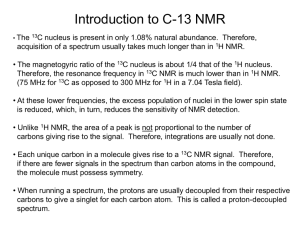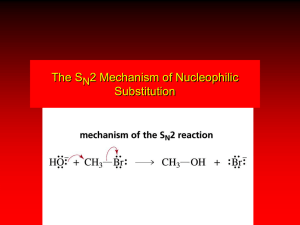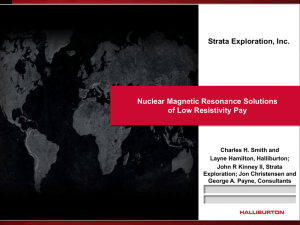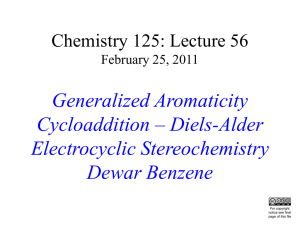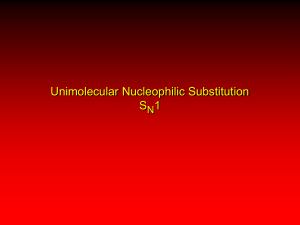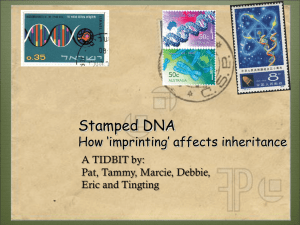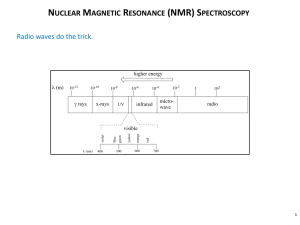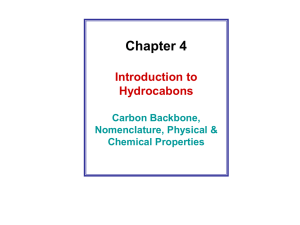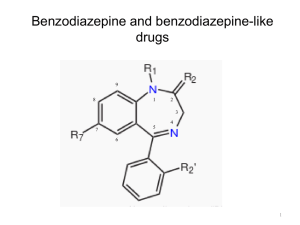H-1 NMR - Oswego
advertisement
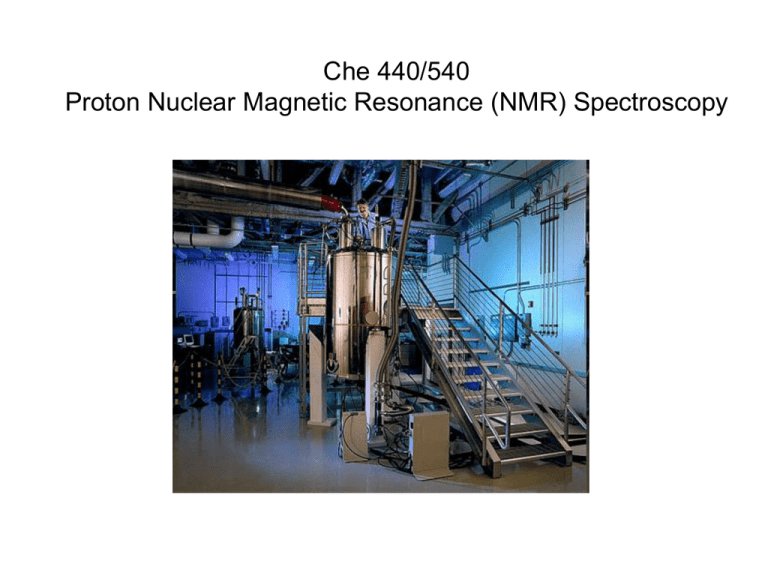
Che 440/540 Proton Nuclear Magnetic Resonance (NMR) Spectroscopy Fundamental NMR Equations Number of energy levels = 2I + 1 I = the spin quantum number (1/2 for 1H and 13C) Therefore, there are two possible spin states for these nuclei. E = h; h = Planck’s constant, = resonant frequency, Hz = Bo/2 Bo = applied magnetic field = gyromagnetic ratio (unique for each NMR active nucleus) E = hBo/2 Characteristics of Some NMR Active Nuclei Natural % Spin (I) Abundance Isotope Magnetic Magnetogyric Moment (μ)* Ratio (γ)† 1H 99.9844 1/2 2.7927 26,753 2H 0.0156 1 0.8574 4,107 11B 81.17 3/2 2.6880 -- 13C 1.108 1/2 0.7022 6,728 17O 0.037 5/2 -1.8930 -3,628 19F 100.0 1/2 2.6273 25,179 29Si 4.700 1/2 -0.5555 -5,319 31P 100.0 1/2 1.1305 10,840 * μ in units of nuclear magnetons = 5.05078•10-27 JT-1 † γ in units of 107 rad T-1 sec-1 Nuclear Spins in the Absence and Presence of a Magnetic Field no magnetic field present Bo Slide by Joanna LeFevre magnetic field present spin state spin state (slight excess) N/N = e-E/kT For a 300 MHz instrument, N/N = 1,000,000/1,000,048. Therefore, for every two million nuclei, there are only 48 excess nuclei in the spin state!! Therefore NMR is an inherently insensitive technique. http://teaching.shu.ac.uk/hwb/chemistry/tutorials/molspec/nmr1.htm A spinning gyroscope in a gravitational field I = +1/2 A spinning charge in a magnetic field magnetic moment, μ I = -1/2 http://www.cem.msu.edu/~reusch/VirtualText/Spectrpy/nmr/nmr2.htm#nmr12b Net Macroscopic Magnetization of a Sample in an External Magnetic Field Bo http://www.cem.msu.edu/~reusch/VirtualText/Spectrpy/nmr/nmr2.htm#nmr12b Excitation by RF Energy and Subsequent Relaxation T1 = spin-lattice relaxation time; establishes the z axis equilibrium. T1’s are usually short (<1 sec) in 1H NMR. They can be quite long (>1 min) in 13C NMR. T2 = spin-spin relaxation time; causes a decrease in magnetization in the x-y plane. For a good magnet, T2 = 1-2 sec. http://www.cem.msu.edu/~reusch/VirtualText/Spectrpy/nmr/nmr2.htm#nmr12b Generation and Fourier Transformation (FT) of a Free Induction Decay (FID) Pattern Complex summation wave (FID) Four different frequencies Fourier transformation http://www.cem.msu.edu/~reusch/VirtualText/Spectrpy/nmr/nmr2.htm#pulse Free Induction Decay (FID) Signal: A Decaying Cosine Curve 5 Hz signal Assume T2 = 2 sec It = Ioe-t/T2 ~35% of signal remains after 2 sec. 0 1 2 3 4 5 seconds http://www.cem.msu.edu/~reusch/VirtualText/Spectrpy/nmr/nmr2.htm#pulse Portion of the FID of Betulin H H OH H HO 0.02 0.02 0.04 0.04 0.06 0.06 Time (sec) 0.08 0.08 H 0.10 0.1 1H Spectrum of Betulin after Fourier Transformation H H OH H HO 5.0 4.5 H 4.0 3.5 3.0 2.5 2.0 1.5 1.0 0.5 Presentation of NMR Data = chemical shift (Hz) – shift of tetramethyl silane (TMS; 0 Hz) = ppm spectrometer frequency (MHz) For example, in CH2Cl2 a sharp singlet occurs at 1,590 Hz using a 300 MHz spectrometer frequency. The chemical shift is: (1,590 – 0) Hz = 5.3 ppm 300 MHz Shielding vs Deshielding CH3 ClCH2 C CH2Cl CH3 Downfield Increasing deshielding Increasing shielding, Bo Upfield Compound, CH3X CH3F CH3OH CH3Cl CH3Br CH3I CH4 (CH3)4Si X F O Cl Br I H Si Electronegativity of X 4.0 3.5 3.1 2.8 2.5 2.1 1.8 Chemical shift, / ppm 4.26 3.4 3.05 2.68 2.16 0.23 0 Electronegative groups attached to the C-H system decrease the electron density around the protons, and there is less shielding (i.e. deshielding) so the chemical shift increases. These effects are cumulative, so the presence of more electronegative groups produce more deshielding and therefore, larger chemical shifts. Compound / ppm CH4 CH3Cl CH2Cl2 CHCl3 0.23 3.05 5.30 7.27 Anisotropic Shielding and Deshielding http://www.chem.ucalgary.ca/courses/351/Carey/Useful/nmr1.gif&imgrefurl 1H NMR Spectrum of 4-Methylbezaldehyde CH3 H H O deshielded protons H Chemical Shifts of Various Protons R R NH OH R Ph Me OH (R) HO CH3 R TMS = Me Ph CH3 R R O O R NR2 O Cl H H H R OCH3 H CH3 CH3 Si Me Me R CH3 CH3 TMS 10 9 Dow nfie ldregion of the spectrum 8 7 6 5 ppm 4 3 2 http://orgchem.colorado.edu/hndbksupport/nmrtheory/NMRtutorial.html 1 0 Upfie ld region of the spectrum Integrations: Relative Numbers of Protons O H3C CH3 O 3 CH3 CH3 1 1H NMR Spectrum of Isopentyl Acetate CH3 H3C O O CH3 6H 2H 1H 3H 2H Spin-Spin Splitting: The n+1 rule in Vicinal Coupling (HA-C-C-HB) Equivalent nuclei do not couple each other. The number of lines in a multiplet is determined by the number of equivalent protons on neighboring atoms plus one, i.e. the n + 1 rule The distance between the peaks is called the coupling constant (3J). The coupling constant is not dependent on the applied field strength. B A B B JAB = 7 Hz JAB = 7 Hz The Origin of Spin-Spin Splitting CH3 CH2 OH http://teaching.shu.ac.uk/hwb/chemistry/tutorials/molspec/nmr1.htm Some Common Splitting Patterns Condition for Applying the n+1 Rule HA HB HA' C C C If JHA-HB = JHA’-HB then the n+1 rule applies and HB appears as a 1:2:1 triplet. However, if the relevant J values are not the same, the splitting is more complex. Example: Cis and Trans Coupling in a Carbon-Carbon Double Bond HA 12 Hz HX O 16 Hz HM HA HX O HM CH2CH2Cl The Karplus Relationship The vicinal coupling constant (3J) is dependent upon the dihedral angle, . http://www.cem.msu.edu/~reusch/VirtualText/Spectrpy/nmr/nmr2.htm#nmr12b Menthol CH3 H1 CH3 H3C OH H3C CH3 H6(eq) HO H2(ax) H6(ax) CH3 H1 3.70 3.60 3.50 3.40 3.30 3.20 3.10 Some Alkene Splitting Patterns http://www.cem.msu.edu/~reusch/VirtualText/Spectrpy/nmr/nmr2.htm#nmr12b Typical 1H-1H Coupling Constants http://www.cem.msu.edu/~reusch/VirtualText/Spectrpy/nmr/nmr1.htm First-Order Coupling The splitting pattern shown below displays the ideal or "First-Order" arrangement of lines. This is usually observed if the spin-coupled nuclei have very different chemical shifts. The condition that must be met is /J > 6. Consider ethyl acetate. HA = 1.26 ppm x 90 Hz/ppm = 113.4 Hz HC = 4.11 ppm x 90 Hz/ppm = 369.9 Hz /J = (369.9 – 113.4)Hz/7.2 Hz = 35.6 http://www.cem.msu.edu/~reusch/VirtualText/Spectrpy/nmr/nmr2.htm#nmr12b Second-Order Coupling However, if the ratio of Δν to J decreases to less than 10 a significant distortion of the expected pattern will take place. First-order http://www.cem.msu.edu/~reusch/VirtualText/Spectrpy/nmr/nmr2.htm#nmr12b Example of a Second-Order Coupling Pattern http://www.cem.msu.edu/~reusch/VirtualText/Spectrpy/nmr/nmr2.htm#nmr12b Magnetic Non-equivalence H(A) and H(B) are magnetically non-equivalent. H(A) and H(A)* couple differently to H(B) [and to H(B*)]. * * Para and Meta-Disubstituted Benzene Rings NO 2 NO2 Cl Cl Mono-Substituted Benzene Ring Increasing the field strength leads to greater dispersion of signals. http://www.cem.msu.edu/~reusch/VirtualText/Spectrpy/nmr/nmr2.htm#nmr12b Chemical Shift Equivalence H’s are homotopic: Related by a 180o rotational axis, Cn. They have the same chemical shift. H C H Chemical Shift Equivalence H’s are enantiotopic: Related by a mirror plane, . They have the same chemical shift. H C NH2 H Chemical Shift Equivalence HA and HB are diastereotopic: They are not related by a rotational axis or a mirror plane. They have different chemical shifts, and they split each other. HB H C HA NH2 CO 2H Homotopic Methyl Groups These methyls are homotopic: they are related by a 180o rotational axis, Cn. They have the same chemical shift. CH3 Cl Cl CH3 Enantiotopic Methyl Groups These methyls are enantiotopic: They are related by a mirror plane, . They have the same chemical shift. CH3 HO CH3 Diastereotopic Methyl Groups These methyls are diastereotopic: They are not related by a rotational axis or a mirror plane. They have different chemical shifts. Notice that a chiral center* is present. H CH3 CH3O C H OH CH3 Compare with isopentyl acetate (enantiotopic methyls) O H3CCOCH2CH2 CH3 H CH3 For the following molecules label any groups that are homotopic, enantiotopic, or diastereotopic. O H3C Br CH3 Br CH3 O OH CH3 OCCH3 HO N H OCH3 NOE Difference Spectra of Pamoic Acid NOE Hd He Hc CO2H Hb OH NOE Ha Hd CH2 OH CO2H Ha http://www.cis.rit.edu/class/schp740/docu/avance/noediff.pdf NOE Difference Spectrum of Betulin Hcis Htrans NOE H3C H OH NOE difference spectrum normal spectrum 4.90 4.80 4.70 4.60 4.50 4.40 Pople Notation: Describes sets of spins If /J > 8, the pattern is called AX (i.e. ethyl acetate). CH3CO2CH2CH3: A3X2 A3 X2 If /J < 8, the pattern is called AB (i.e. 2-chloroacrylonitrile) A H CN H Cl B Three weakly coupled sets are designated AMX; (i.e. styrene) HX M HA HM X A AA’XX’ pattern CO 2H Cl AA’BB’ pattern * * A compound whose 1H NMR spectrum appears below has a molecular formula of C7H14O2. The IR spectrum shows a strong absorbance at 1739 cm-1. Suggest a structure for this compound. 23 mm 23 mm 15 mm 15 mm 15 mm 15 mm
